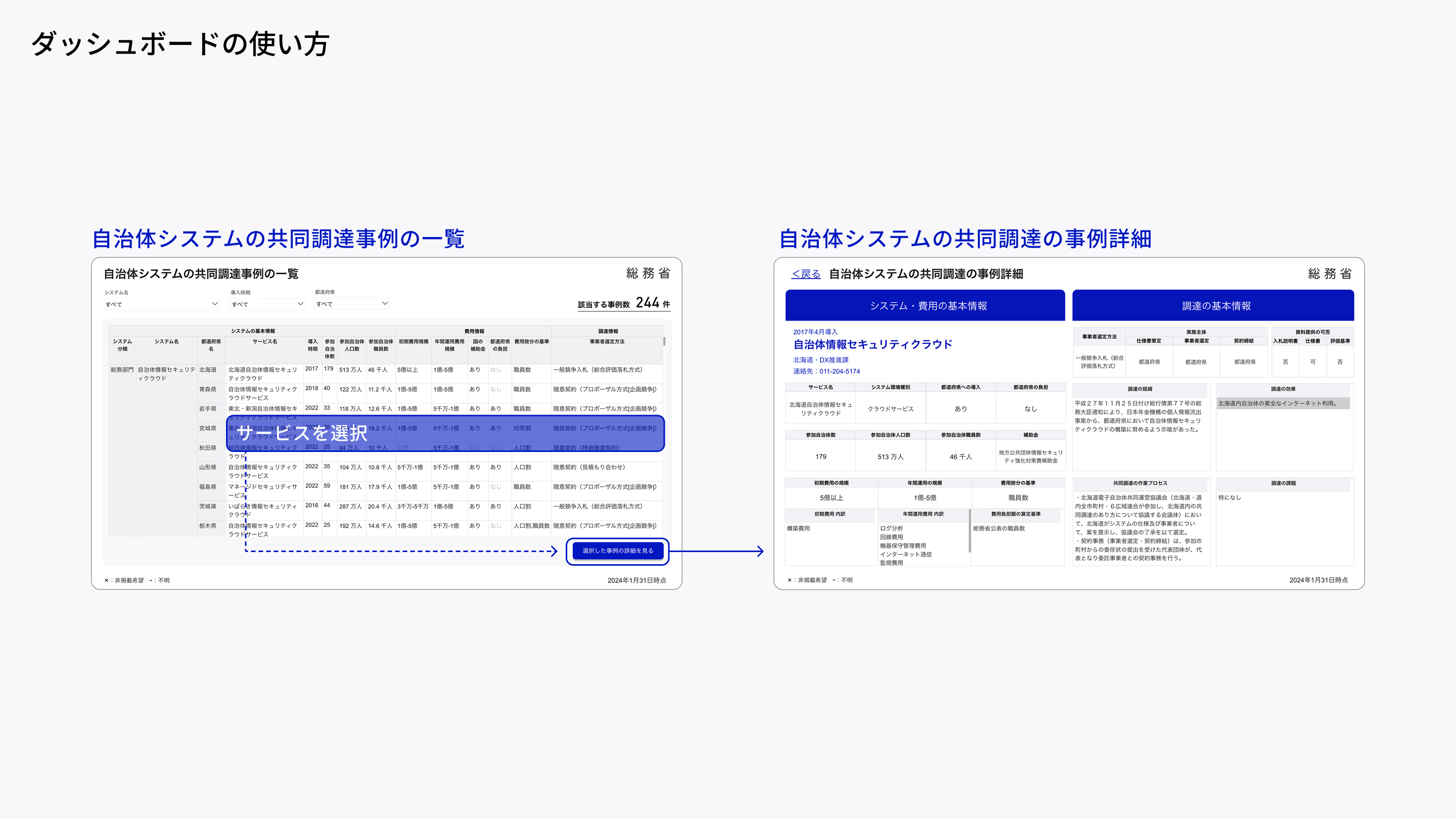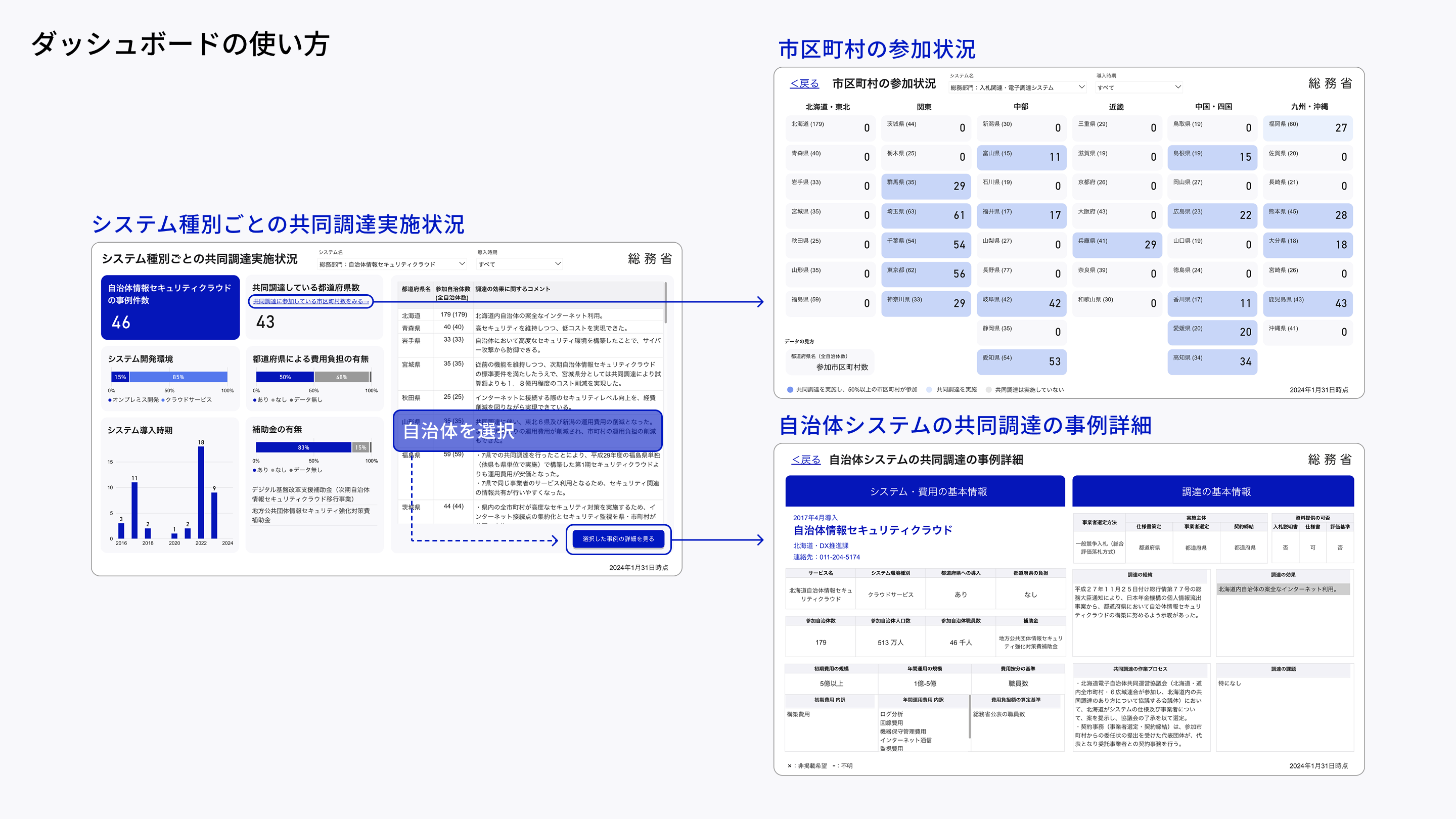Joint Procurement Dashboard for Prefecture-Based Local Government Systems
- Last Updated:
Notice
- August 27, 2025
Examples of joint procurement are listed and updated.
Table of
- What is joint procurement?
- Status of joint procurement
- List and details of joint procurement cases
- Joint procurement by system type
- Joint procurement by prefecture
- Points to Consider
1. What is joint procurement?
Due to the rapid population decline, it is expected that the shortage of personnel for administrative services will also become more serious. In order to respond to this problem, it is essential to improve the efficiency and convenience of public service provision through the use of digital technology.
Joint procurement is a procurement method in which participating organizations jointly procure systems from a single vendor based on a single set of specifications that they have agreed upon.
In particular, joint procurement centered on prefectural governments can be expected to reduce system installation and operation costs through economies of scale and reduce the burden of procedures through the standardization of procedures. It will also be easier for small-scale local governments to introduce the system, and expertise and know-how can be complemented among participating organizations.
The difference between single and joint procurement
| Independent procurement | Joint procurement | |
|---|---|---|
| Procurement Coordination | Each local government must coordinate procurement. | Representative bodies (prefectures, councils, etc.) make procurement-related adjustments (e.g., RFIs, supplier selection, contracts, specification formulation, intention surveys). |
| Procurement cost | Costs tend to remain high due to independent procurement | Introduction and operation costs can be reduced through the effects of splitting the bill and consolidation. |
| Administrative system for procurement | Administrative systems must be established in each local government. | Even small-scale local governments that have difficulty in establishing an adequate system can procure systems |
| Expertise and know-how | There are cases where local governments alone lack human resources and expertise. | Ability to complement know-how and expertise required for human resources and procurement |
| Coordination of information and data | Differences in information and data among local governments | Operations can be standardized among local governments, and information and data can be linked. |
2. Status of joint procurement mainly conducted by prefectures
This graph shows the number of joint procurements conducted mainly by prefectures, divided into three areas: general affairs, business, and tools.
You can check the types of systems that are jointly procured across the country and the number of implementations, and consider candidates for joint procurement.
Examples of joint procurement
As examples of joint procurement, Ministry of Internal Affairs and Communications has disclosed its AI minute preparation system [Kumamoto], electronic contract system [Gifu], child-rearing support app [Nagano], and document management and electronic approval system [Osaka].
3. List and details of joint procurement cases
On the case list page, you can check information such as the number of participating local governments, the population and number of employees of participating local governments, initial costs, and annual operating costs, and you can look for joint procurement cases that are similar in size to your local government.
On the case details page, you can check the cost scale of the joint procurement case, the procurement history, the process, and whether or not specifications can be provided. If you want to know more detailed information for the promotion of joint procurement, you can contact the department in charge of each case to share know-how such as the points of joint procurement in the same system and issues in the process. If the service is registered in a digital marketplace (DMP), you can go to the service details page of your DMP to check the service.

4. Joint procurement by system type
On the joint procurement status page for each system type, you can check the number of joint procurements, whether subsidies were used, and the benefits of procurement that local government officials who conducted joint procurements felt. In addition, you can see the participation of local governments in the systems you are considering procuring, and details of individual cases.

5. Joint procurement by prefecture
You can check the implementation status of joint procurement by prefecture and consider the next system to be procured in your prefecture.
By checking the introduction status of neighboring prefectures, it can also be a material for considering joint procurement across prefectures.
Points to Consider
Refresh Data
We plan to update the various dashboard numbers on a regular basis.
Defining Data
See below for a definition of data.
Source of each data set
The various types of information used in the dashboard are collected from joint procurement cases conducted mainly by prefectural governments (including those conducted by councils, etc. in which prefectural governments are involved as secretariat or observers, etc.) at the request of the Secretariat of the Cabinet Secretariat Digital Administrative and Fiscal Reform Council and Ministry of Internal Affairs and Communications. We have received responses from all prefectural governments for this matter, but cases that were not selected for inclusion, cases that did not receive a response, cases in which the prefectural government was not involved, and cases outside the target period are not included in the dashboard and are not reflected in the statistics on the dashboard.
Data on population and number of employees are based on the following publicly available data (fiscal 2022 figures).
- Population, Vital Statistics and Number of Households Based on the Basic Resident Register (Ministry of Internal Affairs and Communications)
- Survey on the Management of the Number of Staff of Local Ministry of Internal Affairs and Communications
These data are put together and published together as structured data for dashboards.
- DataTable (Excel / 175 kb) (Updated August 27, 2025)
- DataTable (CSV/444KB) (Updated August 27, 2025)
True or false information
For true-or-false information about the date in this dashboard, refer to True-or-false Information: Dashboard on joint procurement of local government systems centering on prefectural governments.
Contact Information
Secretariat of the Cabinet Secretariat Digital Administrative and Fiscal Reform Council
Phone: 03 5253 2111
Regional DX Promotion Office, Ministry of Internal Affairs and Communications Local Government Bureau
Phone: 03 5253 5111
Email: gyousei _ dx _ atmark _ soumu. go. jp
*To prevent spam mail, "@" is displayed as " _ atmark _ ".
When sending mail, please replace " _ atmark _ " with "@" (single-byte).
FAQ
If you have any questions, please check the FAQ .